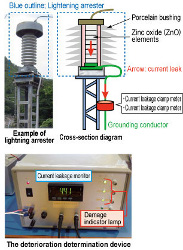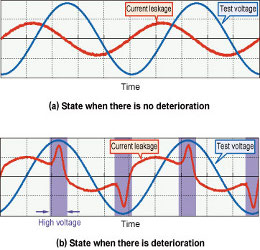24. Device for determining AC feeder lightening arrester damage
Lightning arresters in AC feeding circuits protect electrical equipment from lightning or switching surges. They usually contain zinc-oxide elements inside a porcelain bushing (Figure 1). Given that deterioration of lightning arresters exposes electrical equipment to damage, it is necessary to grasp the state of these arresters on a regular basis. Deterioration of the surface of insulating housing can be detected from increased current leakage, however, it is difficult to check for deterioration of the zinc-oxide elements inside the insulation housing.
If the zinc-oxide elements have been damaged, the leakage current increases when high voltage is applied to the lightning arrester and distorts the waveform (Figure 2). Waveform deformation caused by current leakage can be detected through an increase in a plurality of harmonic currents, and so this effect was employed to develop a device to determine whether the lightning arrester had suffered damage or not.
When lightning arresters are damaged, 5th-15th order harmonic currents can be detected by Rogowski coil and band-pass filters; when the threshold number of harmonic elements is exceeded, the damage indicator lamp lights up, indicating that deterioration has been found.
The validity of the indicator function was verified by artificial fault tests using damaged zinc-oxide elements and a capacitor. Field tests also demonstrated that this method did not misdiagnose undamaged lightning arresters. The device only weighs 10 kg and is compact, facilitating practical on-site inspections, thereby helping to reduce maintenance costs.
Other Contents
- 18. Renovation technology for large scale station widening work
- 19. System for monitoring soundness of railway bridges
- 20. System for evaluating the stability of rock slopes using remote-contactless measurements
- 21. Track maintenance planning systems applying very frequently measured track irregularity data
- 22. Rail gas pressure welding process applicable without specialist welding skills
- 23. Updating of on-board train safety database using wireless technology
- 24. Device for determining AC feeder lightening arrester damage
- 18. Renovation technology for large scale station widening work
- 19. System for monitoring soundness of railway bridges
- 20. System for evaluating the stability of rock slopes using remote-contactless measurements
- 21. Track maintenance planning systems applying very frequently measured track irregularity data
- 22. Rail gas pressure welding process applicable without specialist welding skills
- 23. Updating of on-board train safety database using wireless technology
- 24. Device for determining AC feeder lightening arrester damage


